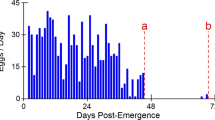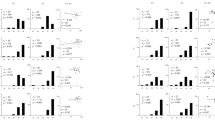Abstract
The number of eggs oviposited, the egg hatchability and the number of offspring produced were measured at 25°C under three light regimes: LL, LD 12 : 12, DD. Two wild genotypes were studied at the same time: a French strain (Colmar) and a tropical African genotype obtained by crossing two strains from Brazzaville and Libreville. These data were compared to those previously obtained with F1 heterozygotes between two inbred laboratory strains (vestigial x Champetières, Allemand et al., 1976).
Significant differences between strains were observed for all the characters considered. Moreover, the responses to the light regimes changed with the genotypes and the characters studied (see Table 2 and Fig. 3) thus demonstrating their genetic independence. In the cases where the treatments had a significant effect, the maximum total egg production was observed in darkness while the maximum egg-hatchability took place under LD 12 : 12. Possible genetic variation within species should always be taken into account in ecophysiological studies.
Similar content being viewed by others
Références
Allemand, R. (1975). Influence de la photopériodicité sur le potentiel reproducteur et le rythme circadien de ponte des Drosophiles. Aspects physiologiques, génétiques et évolutifs. Thèse spécialité, Lyon, 178 p.
Allemand, R., Y. Cohet & J. David. (1973). Increase in the longevity of adult Drosophila melanogaster kept in permanent darkness. Exp. geront. 8: 279–283.
Allemand, R., Y. Cohet & O. Savolainen (1976). Effects of different light regimens on the egg production and egg hatchability of Drosophila melanogaster adults. Acta ent. Bohemslov. 73: 76–85.
Allemand, R. & J. David (1976). The cireadian rhythm of oviposition in Drosophila melanogaster: a genetic latitudinal cline in wild populations. Expermientia: 32: 1403–1406.
David, J. (1971). Particularités biométriques et faible potentiel reproducteur des souches de Drosophila melanogaster provenant du Gabon. C. r. hebd. Séanc. Acad. Sci. Paris 272: 2191–2194.
David, J., C. Biemont & P. Fouillet. (1974). Sur la forme des courbes de ponte de D. melanogaster et leur ajustement à des modèles mathématiques. Archs Zool. exp. gén. 115: 263–277.
David, J. & C. Bocquet. (1975a). Similarities and differences in latitudinal adaptation of two Drosophila sibling species. Nature 257: 588–590.
David, J. & C. Bocquet. (1975b). Evolution in a cosmopolitan species. Genetic latitudinal clines in Drosophila melanogaster wild populations. Experientia 31: 164–166.
David J., J. Boulétreau-Merle, J. Van Herrewege, Y. Cohet, M.F. Arens-Clavel & P. Fouillet (1971). Déterminisme de la fécondité et fonctionnement ovarien chez Drosophila melanogaster. In: ‘Rapport annuel du Groupe lyonnais de Recherche en biologie cellulaire’, Lyon, pp. 61–82.
David, J. & P. Fouillet (1973). Enregistrement continu de la ponte chez Drosophila melanogaster et importances des conditions expérimentales pour l'étude du rythme circadien d'oviposition. Revue Comp. Anim. 7: 197–202.
Dobzhansky, T. (1972). Species of Drosophila: new excitement in an old field. Science 177: 664–669.
Hosgood, S.M.W. & P.A. Parsons (1967). Genetic heterogeneity among the founders of laboratory populations of Drosophila melanogaster. II: Mating behaviour. Aust. J. biol. Sci. 20: 1193–1203.
Médioni, J. (1958). Le comportement de Drosophila melanogaster Melg. dans un appareil à choix lumineux: étude comparative de souches sauvages de provenances géographiques diverses. C.r. Séanc. Soc. Biol., 152: 1004–1007.
Mayr, E. (1966). Animal species and evolution, The Belknap Press of Harvard University Press, Cambridge.
McMillan, M., M. Fitz-Earle, D.S. Robson (1970 a). Quantitative genetics of fertility. I: Lifetime egg production of Drosophila melanogaster—Theoretical. Genetics 65: 349–353.
McMillan, M., M. Fitz-Farle, L. Butler & D.S. Robson (1970b). Quantitative genetics of fertility. II: Lifetime egg production of Drosophila melanogaster—Experimental. Genetics 65: 355–369.
Riemann, J.G. & R.L. Ruud (1974). Mediterrancan flour moth: effects of continuous light on the reproductive capacity. Ann. ent. Soc. Am. 67: 857–860.
Rounbehler, M.D. & J.J. Ellington (1973). Some biological effects of selected light regimes on Trichogramma semifumatum. Ann. ent. Soc. Am. 66: 6–10.
Author information
Authors and Affiliations
Rights and permissions
About this article
Cite this article
Allemand, R. Le potentiel reproducteur des adultes de drosophila melanogaster: Variations génétiques en réponse aux régimes lumineux. Genetica 47, 1–7 (1977). https://doi.org/10.1007/BF00122433
Received:
Accepted:
Published:
Issue Date:
DOI: https://doi.org/10.1007/BF00122433




